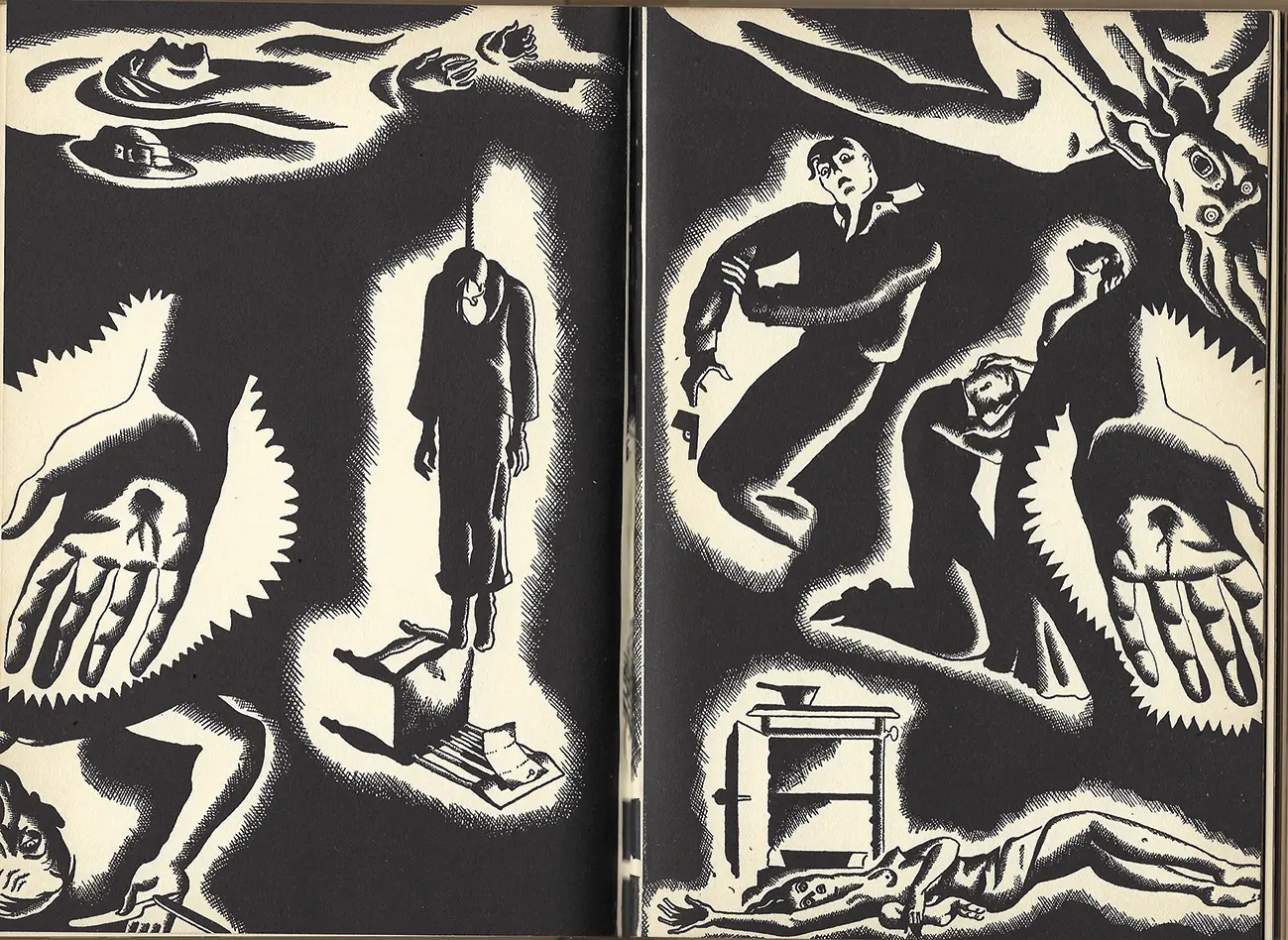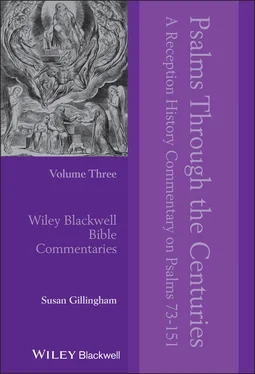Allegorical exegesis provided a rich tradition of visual exegesis in illuminated manuscripts, and again centred on individual verses rather than on the psalm as a whole. For example, the * Theodore Psalter (fol. 100r), alongside verse 1, shows Asaph on a throne, teaching, but the figure of a beardless Christ stands behind, offering inspiration; in the *Bristol Psalter (fol. 125v) and *Barberini Psalter ( fol. 103r) it is Christ himself who is teaching. *Carolingian Psalters are the first to develop the motif of the unicorn. The *Stuttgart Psalter (fol. 108v) depicts an image of a unicorn at the end of the psalm: a hand from heaven points down to the animal, and David is blessing it: this is represented in Plate 2.
A different image is in the *Utrecht Psalter (fol. 45r) where the hand of God points down to a figure (possibly Moses) reading from the law to a crowd of people. Behind him (and three other figures) is a youthful David, crowned, with sheep at his feet; and behind David is a unicorn. 97
The Byzantine *Pantokrator Psalter (fol. 109v) also ends the psalm with a motif inspired by the Latin translation of ‘unicorn’, where here the Virgin is actually suckling the animal. The psalm is actually given a Christian focus from beginning to end. At the beginning in Pantokrator it is Christ, not Moses, who is preaching to the Jews about their disobedience (fol. 102v), and verses 24–25 (on the manna from heaven) depict Christ addressing the Jews (fol. 105r), with an inscription from John 6. 98Verse 65 (‘Then the Lord awoke as from sleep’) has an image in both Pantokrator (fol. 109r) and *Khludov (fol. 78v) of Christ outside the tomb; Khludov adds an image of David facing Christ as if he is prophesying his resurrection. 99 Khludov (fol. 79r) has other interesting illustrations for verses 67–70: of a church on a high mountain, inscribed with ‘Holy Sion’ with the Virgin and Child in a courtyard below; 100at the foot of the mountain is inscribed ‘David anointed by Samuel’, as if the motif of Christ coming from Zion has been prophesied by David himself (using Rom. 11:26 as an interpretative text). 101The fourteenth-century Byzantine Kiev Psalter , by contrast, has David, at the foot of the mountain, pointing towards the summit at the shining icon of Mary and Jesus. 102
The Jewish * Parma Psalter (fol. 107v) by contrast emphasises the didactic nature of this psalm, and the possibility of the obedience of the Jews in learning from the past: a figure in a light red garment raises an open book in his right hand and extends his left to an assembly of eight figures; they look intently at the book which has the first two words of the ten commandments, illustrating verses 1 and 5 and the Jewish message of the psalm overall. 103
Because of its rich interpretation, despite its salutary and serious contents, and on account of its long narrative form, Psalm 78 became a challenging psalm for experimentation in English in the sixteenth-century. Mary *Sidney, for example, casts this in ottava rima : a form of Italian origin, connected with heroic poetry, with eight-line stanzas using ten or eleven syllables, rhyming a-b-a-b-a-b-c-c ; this was the form the Elizabethan poet Michael Drayton used in The Barons’ Warres on account of its ‘majesty, perfection and solidity’. 104Sidney’s account of verse 1–3 (a short example of the twenty-seven stanzas in all) runs as follows: 105
A grave discourse to utter I intend
The age of time I purpose to renew
You, O my charge, to what I teach attend;
Hear what I speak, and what you hear ensue.
The things our fathers did to us commend,
The same are they I recommend to you,
Which though but heard we know most true to be:
We heard, but heard, of who themselves did see…
This psalm has inspired surprisingly little Church music, most of which uses the beginning of the psalm rather than the end. For example, both Giovanni *Gabrieli and Heinrich *Schütz composed pieces, with a Latin setting, nearly half a century after Mary Sidney, of the first three verses of this psalm. Gabrieli’s ‘ Attendite popule meus ’ was performed at St. Mark’s, Venice; Schütz’s ‘ Attendite popule meus legem ’, was probably performed in his church in Dresden. Whether the speaker is assumed to be Christ or Moses is not made explicit. *Handel’s arrangement is different because, using Charles Jennens’ libretto, it is for the concert hall rather than the church. His ‘Israel in Egypt’ was performed in 1739, and the texts are Psalms 105, 106 and 78 rather than anything from Exodus. Psalm 78:12–13 is used in Part I, as part of the ‘Plagues in Egypt’, thus illustrating that the message of the psalm is essentially about the importance of remembering God’s mercy for his people. 106
The theme of God’s overall mercy is also brought out in Arthur *Wragg’s more contemporary stark black and white image of Ps. 78:38: ‘But he, being full of compassion, forgave their iniquity and destroyed them not’ (Figure 2). Wragg, greatly influenced by the Great Depression, sketched the psalms with graphic social comment. Here we see the horrors of the suffering of humanity, and violent deaths throughout time. Yet memory prevails: to the right and left of these interwoven images are two palms: each bears the stigmata. 107

Figure 2 ‘But he, being full of compassion, forgave their iniquity and destroyed them not’ . (Ps. 78:38).
Source : Wragg, A. 1934: The Psalms for Modern Life . New York: Claude Kendall.
The reception of this psalm testifies in both faith traditions to the importance of remembering, followed by penitence and trust in God’s mercy, with each tradition recognising the ‘parabolic’ nature of the psalm. Christian readings, through verbal and visual exegesis, have been more allusive, whilst nevertheless emphasising the motif of human failure in this psalm.
Psalm 79: A Communal Lament about Ongoing Exile (i)
Psalm 79 marks an abrupt contrast with Psalm 78, in that whereas 78 ends with the hope that God has chosen David and Zion, this psalm begins with the Temple and city having been destroyed. But the placing of these two psalms is not accidental. The references to the gift of food in 78:24–29 now contrast with the people being like food to be consumed by their enemies (79:2). The blood-like rivers in 78:44 are now a reminder of the spilt blood of God’s people (79:3). From having been fed exceedingly ( me’od ) well in the desert (78:29) the people are now brought exceedingly ( me’od ) low (79:8). Even if these correspondences are coincidences, the general contrast is deliberate: the great miracles described in Psalm 78 are now replaced with groans from the people and taunts from the enemies (79:11–12). And yet the psalm ends, as in Psalms 78 and 77, with knowing that the people are still God’s flock (78:71 and 79:13).
Psalm 79 continues this second group of *Asaphite psalms (78–83), with the military and nationalist details and the same spirit of questioning having resonances with the first group (73–77). It is possible to discern three strophes in the lament form of Psalm 79: verses 1–4 describe the oppression by enemy nations; verses 5–9 question God in prayer, using the familiar phrase ‘How Long?’; and verses 10–13, addressing God with imperative pleas, imagine the overturning of the nations. Thus there is some movement in the psalm towards hope for a change of fortune. One of the problems is that the psalm has a large store of formulaic language, so that, for example, in trying to account for the obvious correspondences between verse 4 and 44:14, between verse 5 and 89:46, and between verse 11 and Ps. 102:20, it is difficult to know which text has used the other, or indeed if each is from a common liturgical and formulaic source.
Читать дальше













